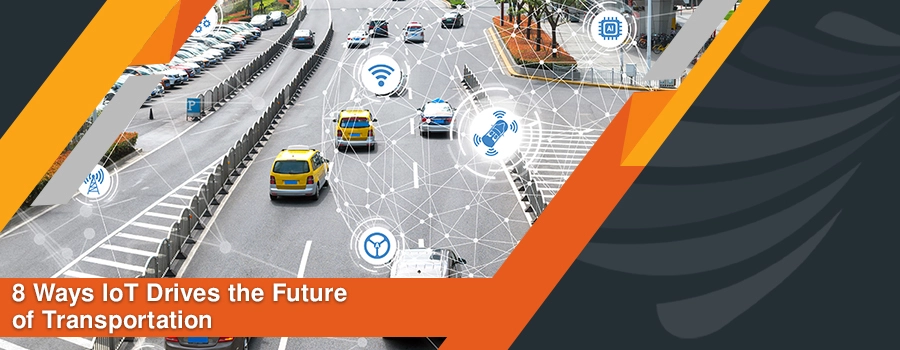In today’s era of technological advancement, the Internet of Things (IoT) has emerged as a driving force in solving complex issues across various industries, including transportation. IoT plays a crucial role, from optimizing efficiency to enhancing safety measures. In this blog, we invite you to explore the eight ways IoT is shaping the future of transportation, revolutionizing our daily commute by addressing everyday traffic challenges.

Join us in exploring innovative applications of IoT technology, reshaping traffic patterns, and paving the way for a better future.
Understanding the Global Transport Crisis
Globally, issues related to traffic management have led to congestion, greenhouse gas emissions, air and noise pollution, as well as road accidents and collisions. Health organizations are concerned about road accidents as they result in severe health issues, causing approximately 1.35 million deaths or disabilities annually. In 2019, an estimated 1.3 million deaths were related to road traffic injuries, with 93% occurring in low- and middle-income countries. By 2030, traffic accidents are projected to become the seventh leading cause of death globally, highlighting the severity of this issue.
What is IoT-Supported Transport Management?
Traditional transport management often results in higher carbon emissions and fuel consumption. IoT-supported transport management utilizes IoT technology applications to streamline and optimize various components of transportation systems. This encompasses various applications such as fleet management, logistics, infrastructure, and vehicles.
IoT-supported traffic management requires the integration of sensors, connectivity, data analytics, and automation to obtain real-time data, make informed decisions, and enhance the overall effectiveness, safety, and sustainability of traffic networks.
8 Ways IoT is Shaping the Future of Transportation
Due to inadequate transportation infrastructure, the transportation industry faces numerous challenges. With the aid of IoT technology, these challenges can be addressed, opening new avenues for better transportation infrastructure that is more efficient, user-friendly, environmentally friendly, and sustainable. Let’s explore how IoT is addressing the most pressing issues in the traditional transportation industry:
-
Reducing Fuel Consumption
Traditional route management often leads to higher carbon emissions and fuel consumption. IoT-supported route management systems utilize real-time data to optimize routes, thereby reducing emissions and fuel usage. According to McKinsey & Company analysis, IoT-supported route optimization can save up to 15% in fuel usage. Additionally, IoT sensors such as motion and heat sensors can intelligently utilize energy resources, saving on transportation costs for administrators.
-
Enhanced Public Transport Systems
Smart public transportation can be achieved through IoT sensors, allowing passengers to track the real-time location of public buses via mobile applications. Smart public transportation services aid in better commuter planning, allowing drivers to navigate through optimal routes, avoid traffic congestion, and save energy and time. They encourage people to choose public buses over private vehicles, thereby reducing fuel costs. This ultimately reduces traffic congestion and carbon emissions from a large number of private vehicles.
-
Smart Parking Solutions
IoT smart parking systems, such as ParkSmart, provide real-time data on parking space availability. Users can track nearby parking lots and reserve parking spaces via mobile applications. This can save them time, money, and fuel while reducing traffic congestion, accidents, and mismanagement. Furthermore, installing IoT sensors in parking lots can enhance convenience for vehicle owners and lower operational and maintenance costs.
-
Strengthened Fleet Management
IoT-supported fleet management systems, such as TrackPro, enable real-time tracking of vehicles, even sending notifications when vehicles cross predefined virtual boundaries. Such IoT solutions enable fleet managers to track their assets and minimize the likelihood of operational inefficiencies and delays.
-
Advanced Truck Operations Efficiency
By monitoring and tracking in real-time, IoT solutions enable freight organizations to improve the operational efficiency of their fleets. The American Transportation Research Institute claims that predictive maintenance enabled by IoT technology can reduce vehicle downtime by up to 75%. Additionally, engine oil leak warnings enable preventive maintenance, reducing downtime and improving vehicle performance. This reduces the likelihood of unforeseen breakdowns and ensures smoother operations.
-
Supply Chain Management
IoT-supported transport management solutions enable end-to-end visibility and tracking of goods in transit. IoT sensors attached to goods can monitor humidity, location, and temperature. This helps stakeholders to have real-time insights into the status and condition of goods throughout the supply chain. Such IoT solutions also assist drivers in selecting the optimal routes for timely arrival at their destinations and avoiding traffic hassles. Furthermore, IoT-driven fleet management systems provide weather updates to drivers, helping them choose suitable travel times and avoid accidents.
-
Environmental Sustainability
IoT plays a crucial role in addressing environmental issues and promoting sustainable transportation. By providing alternatives such as carpooling and cycling, as well as transitioning to electric vehicles, IoT helps to reduce greenhouse gas emissions and improve air quality. Additionally, IoT-supported traffic management systems can optimize traffic flow, promote eco-friendly driving behaviors, reduce idle time, and alleviate traffic-related environmental issues.
-
Enhanced Travel Experience
IoT-driven applications are also transforming the travel experience by providing real-time information and personalized services. Data collection aids in analyzing user needs, while integration of artificial intelligence algorithms analyzes user behavior to provide personalized recommendations. Drivers can access robust Wi-Fi connections and receive personalized song and movie recommendations based on their preferences on-screen. Additionally, people with disabilities can receive automatic assistance to enhance their driving experience. Integration with augmented reality provides users with comprehensive guidance on their routes and sends alerts to avoid emergencies and accidents.
Conclusion
The combination of IoT and traffic management is revolutionizing the way we commute and address daily traffic issues. By leveraging real-time data, connectivity, and automation, IoT enhances safety, efficiency, and sustainability, fundamentally changing how we experience and navigate the world. As we embrace the possibilities of IoT-driven transportation, we embark on a journey towards a future where travel is seamless, convenient, and environmentally friendly, promising a better tomorrow for generations to come.


